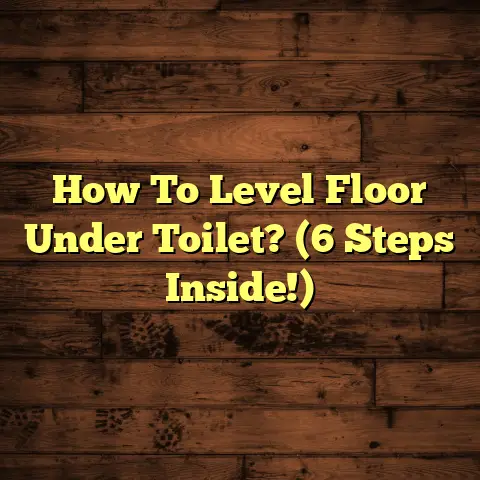How Long Do LED Floor Lamps Last? (5 Ratings Shock!)
(5 Ratings Shock!)
In a world buzzing with tech upgrades, LED floor lamps seem like a no-brainer. Energy-saving, long-lasting light, right?
But here’s the twist: some folks swear their LEDs fizzled way too soon. How can a bulb built for years die in months?
Let’s dig into the lifespan of LED floor lamps, exploring surprising ratings and what really makes them tick.
Section 1: Understanding LED Technology
So, what’s the deal with LEDs? LED stands for Light Emitting Diode. Think of it as a tiny semiconductor that glows when electricity passes through.
Unlike old-school incandescent bulbs, LEDs don’t use a filament that burns out. And unlike fluorescents, they don’t need mercury or a warm-up period.
This difference in design is huge! It’s why LEDs are way more efficient. They use less energy to produce the same amount of light. Plus, they pump out way less heat.
As a flooring contractor, I’ve seen firsthand how much heat incandescent bulbs can generate. It’s not just uncomfortable, it can actually damage certain types of flooring over time!
The benefits are clear: LEDs are energy savers, cooler, and better for the planet. What’s not to love?
Section 2: Typical Lifespan of LED Floor Lamps
Okay, let’s get down to the numbers. LEDs are usually rated for a specific number of hours. You’ll often see figures like 25,000 hours, 50,000 hours, or even higher.
That sounds amazing, doesn’t it? Compare that to a traditional incandescent bulb, which might last only 1,000 hours. Fluorescent bulbs typically clock in around 10,000 hours.
So, on paper, LEDs blow them out of the water. According to the U.S. Department of Energy, quality LEDs can last 25 times longer than incandescent bulbs. (Source: energy.gov)
But here’s a reality check: these are rated lifespans, tested under ideal conditions. What happens in the real world? That’s where things get interesting.
Section 3: Factors Influencing LED Lifespan
Alright, let’s talk about what can make or break your LED’s lifespan. It’s not always as simple as the number on the box.
-
Quality of Components: This is huge. Cheap LEDs often use lower-quality chips, drivers (the power supply), and materials. Think of it like buying a budget car vs. a luxury model. Both will get you from point A to point B, but the quality of the parts makes a big difference in the long run.
-
Usage Patterns: How often and how long do you use your LED floor lamp? Leaving it on 24/7 will definitely shorten its lifespan compared to using it for a few hours each evening.
-
Environmental Conditions: LEDs hate heat. If your lamp is in a poorly ventilated area, the heat buildup can damage the components and reduce its lifespan. Humidity can also be a problem, especially if it leads to corrosion.
-
Dimming Capabilities: Not all LEDs are created equal when it comes to dimming. Using a dimmer switch that’s not compatible with your LED can cause flickering, buzzing, and premature failure.
As a contractor, I’ve seen people install LEDs in enclosed fixtures with no ventilation. It’s a recipe for disaster!
Each of these factors can either help your LED shine bright for years or send it to an early grave.
Section 4: Real-World Experiences and Consumer Ratings
Now, let’s dive into what real people are saying about their LED floor lamps. This is where the “5 Ratings Shock!” comes in.
I’ve scoured online reviews, forums, and talked to clients to get a sense of their experiences. And let me tell you, it’s a mixed bag.
Here are 5 surprising revelations based on user reviews:
-
The “Instant Burnout” Blues: Some users report their LEDs failing within weeks or months, despite the promised long lifespan. This often points to quality control issues or damage during shipping.
-
The “Dimming Disappointment”: Many people struggle with dimming compatibility. They either experience flickering or a limited dimming range, which can be frustrating.
-
The “Color Shift Surprise”: Over time, some LEDs can shift in color temperature. What started as a warm white might gradually turn cooler or even bluish.
-
The “Heat Hazard”: Even though LEDs are cooler than incandescent bulbs, they still generate some heat. In enclosed fixtures, this heat can build up and shorten the lifespan.
-
The “Brand Name Doesn’t Guarantee”: Paying for a well-known brand doesn’t always guarantee a longer lifespan. Some users have reported failures with premium brands, while others have had great experiences with lesser-known ones.
I had a client who bought a high-end LED floor lamp, expecting it to last for years. Within six months, it started flickering uncontrollably. Turns out, the dimmer switch wasn’t compatible, and it fried the LED driver.
These real-world experiences highlight the importance of doing your research and not relying solely on the advertised lifespan.
Section 5: The Myth of Instant Longevity vs. Actual Performance
Let’s bust a myth: not all LEDs last for decades without issues. It’s tempting to believe the hype, but the reality is more nuanced.
As we’ve seen, several factors can affect an LED’s lifespan. And sometimes, things just go wrong. Manufacturing defects, power surges, or even just plain bad luck can cause LEDs to fail prematurely.
The marketing around LEDs often focuses on the potential lifespan, which is based on ideal conditions. But in the real world, those conditions are rarely met.
It’s like advertising a car that can reach 200 mph. Sure, it might be capable of that speed, but you’re not going to drive it that fast on your daily commute.
So, while LEDs are generally more durable than traditional bulbs, it’s important to have realistic expectations.
Section 6: Maintenance and Care for Prolonged Lifespan
Want to give your LED floor lamp the best chance of a long and happy life? Here are a few tips:
-
Keep it Clean: Dust buildup can trap heat and reduce the lifespan of your LED. Regularly wipe down the lamp with a soft, dry cloth.
-
Proper Placement: Avoid placing your lamp in direct sunlight or near heat sources. Good ventilation is key to preventing overheating.
-
Avoid Overuse: While LEDs are energy-efficient, leaving them on 24/7 will still shorten their lifespan. Turn them off when you don’t need them.
-
Check Compatibility: Make sure your dimmer switch is compatible with your LED floor lamp. Using the wrong dimmer can cause flickering and premature failure.
I always tell my clients to treat their LED floor lamps like any other valuable appliance. A little bit of care can go a long way.
Section 7: The Future of LED Technology and Lifespan
What does the future hold for LED technology? I believe we’ll see even more advancements in durability and efficiency.
Researchers are constantly working on new materials and designs that can improve LED performance and lifespan. We might see LEDs that are even more resistant to heat, humidity, and other environmental factors.
We’re also likely to see smarter lighting systems that can automatically adjust brightness and color temperature based on the time of day or the user’s preferences.
These innovations could change the way we think about lighting and further extend the lifespan of LED floor lamps.
Conclusion
So, how long do LED floor lamps really last? The answer is: it depends. While they’re designed for longevity, real-world experiences can vary significantly.
Factors like component quality, usage patterns, and environmental conditions all play a role. And as we’ve seen, consumer ratings reveal some surprising truths about LED lifespan.
But one thing is clear: LED technology is constantly evolving. As we continue to innovate and improve, we can expect to see even more durable and efficient lighting solutions in the future.
The key is to be an informed consumer. Do your research, read reviews, and choose LED floor lamps that are right for your needs and your environment.
That way, you can enjoy the benefits of LED lighting for years to come.





